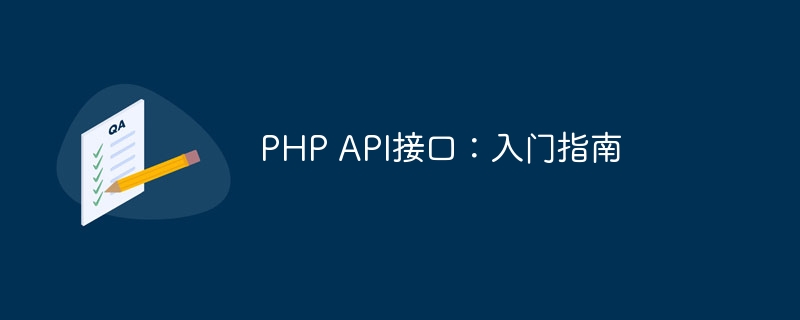

PHP is a popular server-side scripting language used for building web applications and websites. It can interact with various different types of API interfaces and is very convenient during the development process. In this article, we will provide an introductory guide to the PHP API interface to help beginners learn to use it faster.
What is API?
API stands for "Application Programming Interface", a standardized way that allows different applications to exchange data and information. This interaction is accomplished by accessing a web service on a website. A web service is a software system running on a web server that can interact with external applications and provide a way to access their internal data.
Why use PHP API interface?
Using the PHP API interface can help developers communicate with Web services more quickly. The API interface can provide consistent interfaces and data formats, thereby simplifying the development process. PHP is a popular server-side scripting language, so it is compatible with many different web services and APIs.
PHP API Interface Tutorial
Now we will provide some useful steps to help you get started using the PHP API interface.
1. Understand the API used
Before using the API, you need to understand the specific language and format used by the API. Most API providers provide detailed documentation and sample code. Use these resources to help you better understand how to use the API.
2. Install PHP and set up the development environment
Installing PHP and configuring the development environment is the first step to use the PHP API interface. You need to use the latest version of PHP and make sure PHP is in the correct configuration. You can use tools like XAMPP, MAMP or WAMP to easily set up a PHP development environment. Once the installation is complete, you need to verify that PHP is installed correctly and executed on the server.
3. Use the cURL library to interact with the API
Once you have set up your development environment, you can next use the cURL library to interact with the API. cURL is a widely used PHP library that helps you send requests and handle responses from APIs. When using cURL, you need to use the following steps:
a. Initialize a cURL session
b. Set the request URL and request parameters
c. Perform the HTTP request
d. Process the API response results
Here is a basic code example of using cURL to interact with the API:
$url = "http://example.com/api/get_data";
$data = array('param1' => 'value1', 'param2' => 'value2');
$ch = curl_init();
curl_setopt($ch, CURLOPT_URL, $url );
curl_setopt($ch, CURLOPT_POST, 1);
curl_setopt($ch, CURLOPT_POSTFIELDS, $data);
curl_setopt($ch, CURLOPT_RETURNTRANSFER, true);
$response = curl_exec($ch);
curl_close ($ch);
$result = json_decode($response, true);4. Processing the API response
Once you get the response from the API, you need to parse the response data and processed as needed. You can use a JSON parser such as JSONArray or JSONObject to parse the API response and perform necessary operations with the returned data.
5. Error handling and debugging
Finally, when you use the API, errors or problems are inevitable. When using the PHP API interface, you need to handle errors and debug errors carefully. You can use the following suggestions to better manage errors:
a. Turn on PHP error reporting
b. Use error handlers and logging tools
c. Use debugging tools (such as Xdebug) Develop and debug
Conclusion
Using the PHP API interface can quickly and accurately access Web services and obtain valid data and information from them. Before you start using an API, make sure you understand how to use a specific API, properly configure your development environment, and have basic knowledge of cURL and JSON parsers. If you understand how to use APIs correctly and handle errors carefully, you can reduce errors and make the development process more efficient.
The above is the detailed content of PHP API Interface: Getting Started Guide. For more information, please follow other related articles on the PHP Chinese website!